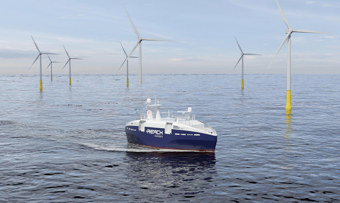
Protection for our coastlines
With many countries becoming increasingly aware of potential threats to their coastlines, Kongsberg Maritime’s UT range of ships has been designed specifically to tackle the many and varied challenges that may emerge.
-
Text:Global Sales and Marketing
Photo:©Kongsberg Maritime | ©Knud Rasmussen
-
CRAIG TAYLORSenior Manager PR & Communications
The Danish Navy operates two NVC 810 offshore patrol vessels.
One area where the Kongsberg Maritime ship design team has been able to transfer technology and experience into a relatively niche segment, is in a range of governmental and special purpose ships, which draw on the robust capabilities of the company’s design portfolio.
With around 30 references, a range of Kongsberg Maritime designs with specific mission critical requirements are in service with navies, coastguards and other government departments.
The UT range was expanded to include three designs suited to coastguard and naval duties. The UT 512, UT 515 and UT 517 have been delivered since 2005 and are suited to a variety of duties.

Many countries are increasingly aware of potential threats to their coastlines and the area within their exclusive economic zones (EEZ). Those threats vary, so there’s a real need for adaptable and multi-purpose ships, and we have a broad portfolio of adaptable designs to meet the demanding requirements of our governmental customers.Einar Vegsund, Kongsberg Maritime’s Vice President – Ship Design
“This can include fisheries protection, emergency towing of ships which represent a pollution hazard, especially if there’s a risk of them drifting ashore, as well as pollution control and clean-up operations. These ships have a pedigree of operating in the harshest environments, so are perfect in performing critical roles not only in defence, but environmental protection, particularly through their impressive towing power.
“Our extensive experience of commercial shipbuilding standards means we can give our naval customers fully capable vessels with the latest, proven technology for a lower cost than traditional navy-classed vessels.”

The KV Harstad entered service in 2005.
UT design evolves for crucial missions
The first UT design, specifically for coast guard operations, was the Norwegian vessel KV Harstad. Entering service in 2005 and designated a UT 512, the polar ice class vessel has proved very successful.

One of the Harstad’s most important duties is pollution prevention. For towing and emergency work it has an optimally located towing winch, a reinforced pushbow, FiFi 1 firefighting capability, a hospital, and extensive equipment including line throwing gear, a harpoon system for attaching the tow wire to stricken vessels, oil spill booms and skimmers and 1,000m³ of tankage for recovered oil. The vessel is also able to support the NATO Submarine Rescue System.
Iceland, with similar operational requirements to Norway, followed suit, but with a larger ship, adapted for the country’s requirements. The ship, a UT 512L design, named Thor, is 10 metres longer (93 metres) than the Norwegian ship, and accommodates a range of additional features. The Thor is capable of more than 20 knots and has accommodation for 48 people. One of the ship’s key roles is to provide on-scene command and coordination in the event of natural disasters, such as volcanic eruptions, where sea and air rescue is a crucial part of Iceland’s emergency response.
Operating over a very large area in a region with challenging weather conditions, the Thor has a critical role. Its duties cover fishery control, standby and rescue, emergency towing, pollution prevention, oil recovery and firefighting. Thor is a powerful ship with a bollard pull of 110 tonnes, which was specified so it is able to tow stricken tankers of up to about 200,000dwt.
With around 30 references, a range of Kongsberg Maritime designs with specific mission critical requirements are in service with navies, coastguards and other government departments.
The Indian Coast Guard was a key customer for the UT, and one of the first to order multiple ships. With a significant increase in tanker traffic expected in India’s waters, Kongsberg Maritime’s UT 517 designs were the ideal solution to match emerging requirements.
Known as the Samudra-class, the three ships are deployed on a wide range of duties around India’s coastline. They are equipped with oil booms and skimmers and will have the ability to either hold about 300 tonnes of recovered oil on board or transfer it to barges towed astern. The vessels are armed and carry a helicopter.
The UT governmental ships in service in the UK, France, Spain and Algeria all have a common role, and that’s a powerful towing capacity. The NVC design range includes options for naval craft. The Royal Danish Navy operates two NVC 810 offshore patrol vessels – Knud Rasmussen and Ejnar Mikkelsen. Primarily operating off Greenland, the 71.8-metre vessels have a top speed of around 17 knots and are designed for a wide range of Arctic and coastal operations.
Einar Vegsund, Vice President - Ship Design
Visit our website
Decarbonisation by design.

